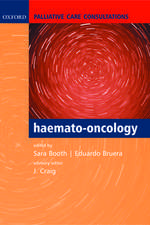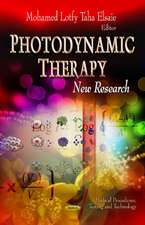History of Research on Tumor Angiogenesis
Autor Domenico Ribattien Limba Engleză Paperback – 19 oct 2010
Beginning in the 1980’s, the biopharmaceutical industry began exploiting the field of antiangiogenesis for creating new therapeutic compounds for modulating new blood vessels in tumor growth. In 2004, Avastin (Bevacizumab), a humanized anti-VEGF monoclonal antibody, was the first angiogenesis inhibitor approved by the Food and Drug Administration for the treatment of colorectal cancer. At present, it has been estimated that over 20,000 cancer patients worldwide have received experimental form of antiangiogenic therapy.
This book offers a historical account of the relevant literature. It also emphasizes the crucial and paradigmatic role of angiogenesis as a biological process and the significance of antiangiogenic approach for the treatment of tumors.
| Toate formatele și edițiile | Preț | Express |
|---|---|---|
| Paperback (1) | 1085.49 lei 6-8 săpt. | |
| SPRINGER NETHERLANDS – 19 oct 2010 | 1085.49 lei 6-8 săpt. | |
| Hardback (1) | 1092.43 lei 6-8 săpt. | |
| SPRINGER NETHERLANDS – 15 ian 2009 | 1092.43 lei 6-8 săpt. |
Preț: 1085.49 lei
Preț vechi: 1142.62 lei
-5% Nou
Puncte Express: 1628
Preț estimativ în valută:
207.76€ • 214.11$ • 175.40£
207.76€ • 214.11$ • 175.40£
Carte tipărită la comandă
Livrare economică 03-17 martie
Preluare comenzi: 021 569.72.76
Specificații
ISBN-13: 9789048181568
ISBN-10: 9048181569
Pagini: 136
Ilustrații: X, 126 p.
Dimensiuni: 155 x 235 x 7 mm
Greutate: 0.2 kg
Ediția:Softcover reprint of hardcover 1st ed. 2009
Editura: SPRINGER NETHERLANDS
Colecția Springer
Locul publicării:Dordrecht, Netherlands
ISBN-10: 9048181569
Pagini: 136
Ilustrații: X, 126 p.
Dimensiuni: 155 x 235 x 7 mm
Greutate: 0.2 kg
Ediția:Softcover reprint of hardcover 1st ed. 2009
Editura: SPRINGER NETHERLANDS
Colecția Springer
Locul publicării:Dordrecht, Netherlands
Public țintă
ResearchCuprins
1: 1.1 Early evidence of the vascular phase and its importance in tumor growth. 1.2 Early evidence of tumor cells releasing specific growth factors for blood vessels. 1.3 Tumors in isolated perfused organs: absence of angiogenesis. 1.4 The avascular and the vascular phases of solid tumor growth. 2: 2.1 Isolation of the first angiogenic tumor factor. 2.2 The discovery of basic fibroblast growth factor/fibroblast growth factor-2. 2.3 The discovery of vascular permeability factor/vascular endothelial growth factor. 2.4 The discovery of angiopoietins. 3: 3.1 How do tumor cells switch to the angiogenic phenotype ? 3.2 The concept of angiogenic switch. 3.3 Factors involved in the angiogenic switch. 3.4 What is the evidence that genetic instability promotes the angiogenic switch ? 4: 4.1 Tumor endothelial cells features. 4.2 Tumor basement membrane. 4.3 Tumor pericytes. 5: 5.1 Tumor lymphangiogenesis. 6: 6.1 The contribution of inflammatory cells to tumor angiogenesis. 7: 7.1 The role of endothelial progenitor cells in tumor angiogenesis. The first isolation of putative endothelial progenitor cells. 7.2 Characterization of endothelia progenitor cells. 7.3 Triggers and inhibitors of endothelial progenitor cells to sites of active neovascularisation. 7.4 The transplantation models to study endothelial progenitor cells. 7.5 The identification of bone marrow-derived multipotent progenitor cells. 7.6 Monocyte/macrophage as a source of endothelial progenitor cells. 7.7 Contribution of endothelial progenitor cells to tumor angiogenesis. 8: 8.1 Tumor microvascular density as a prognostic indicator. 8.2 Use of panendothelial cell markers. 8.3 Topography. 8.4 Certain human tumor types can exhibit lower microvascular density that the corresponding normal tissues. 8.5 Prognostic value of microvascular density. 8.6 The relationship between microvascular density and intercapillary distance. 9: 9.1 Inhibitors of angiogenesis. 9.2 Metronomic chemotherapy. 9.3 Receptor tyrosine kinase (RTK) inhibitors. 9.4 Inhibitors of VEGF. 9.5 Antiangiogenic monoclonal antibodies: towards the discovery of Avastin. 9.6 Microvascular density has not been shown to be a valid measurement to guide or evaluate antiangiogenic treatment. 9.7. Perspectives. References.
Textul de pe ultima copertă
In 1971, J. Folkman published in the "New England Journal of Medicine" a hypothesis that tumor growth is angiogenesis-dependent. Folkman introduced the concept that tumors probably secrete diffusible molecules that could stimulate the growth of new blood vessels toward the tumor and that the resulting tumor neovascularization could conceivably be prevented or interrupted by angiogenesis inhibitors. Solid and haematological tumors consist of an avascular and a subsequent vascular phase. Assuming that this depends on the release of angiogenic factors, acquisition of angiogenic capability can be seen as an expression of progression from neoplastic transformation to tumor growth and metastasis.
Beginning in the 1980's, the biopharmaceutical industry began exploiting the field of antiangiogenesis for creating new therapeutic compounds for modulating new blood vessels in tumor growth. In 2004, Avastin (Bevacizumab), a humanized anti-VEGF monoclonal antibody, was the first angiogenesis inhibitor approved by the Food and Drug Administration for the treatment of colorectal cancer. At present, it has been estimated that over 20,000 cancer patients worldwide have received experimental form of antiangiogenic therapy.
This book offers a historical account of the relevant literature. It also emphasizes the crucial and paradigmatic role of angiogenesis as a biological process and the significance of antiangiogenic approach for the treatment of tumors.
Beginning in the 1980's, the biopharmaceutical industry began exploiting the field of antiangiogenesis for creating new therapeutic compounds for modulating new blood vessels in tumor growth. In 2004, Avastin (Bevacizumab), a humanized anti-VEGF monoclonal antibody, was the first angiogenesis inhibitor approved by the Food and Drug Administration for the treatment of colorectal cancer. At present, it has been estimated that over 20,000 cancer patients worldwide have received experimental form of antiangiogenic therapy.
This book offers a historical account of the relevant literature. It also emphasizes the crucial and paradigmatic role of angiogenesis as a biological process and the significance of antiangiogenic approach for the treatment of tumors.









